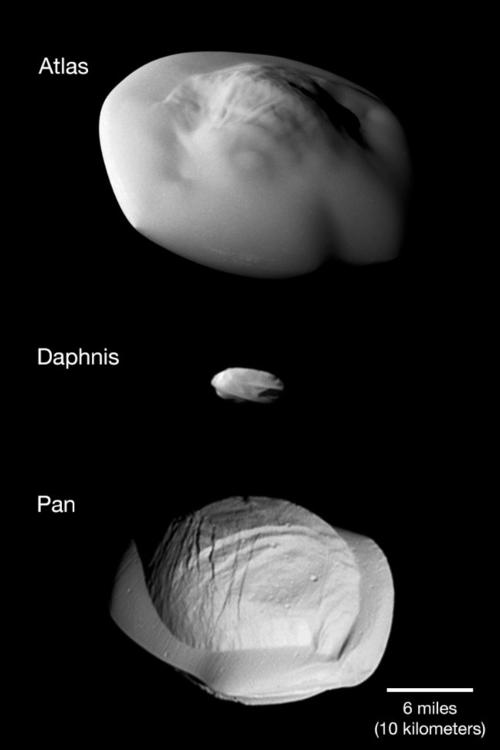Cassini mission reveals the secrets of Saturn’s walnut-shaped ring moons
New study in the high-ranking journal Science
№ 73/2019 from Mar 29, 2019
A new study of Saturn’s small inner moons was published in the high-ranking journal Science. Images of Pan, Daphnis, Atlas, Pandora, and Epimetheus, obtained by the Cassini spacecraft in winter 2016/17, show that several of these so-called “shepherd moons” exhibit huge ridges around their equators, giving them a very peculiar and impressing walnut-like shape (Fig. 1). The report includes contributions of Freie Universität Berlin scientists Frank Postberg, Tilmann Denk, Nozair Khawaja, and Heike Rosenberg from the Department of Earth Sciences, Planetary Sciences and Remote Sensing.
The “brims” of these highly irregularly-shaped small inner moons are probably created by tiny dust particles originating from the surrounding rings that are collected by the moons' small gravities over millions of years. This idea is substantiated further by the low densities of the inner moons and their porous surfaces inferred by the Cassini instruments.
In addition to ice grains from the main rings that lie for the most part inside their orbits, the bright surfaces are also accumulating icy particles and water vapor ejected by the larger moon Enceladus from outside the main ring system (Fig. 2). However, a mixture of organic materials and possibly iron again originating from the main ring system probably causes the reddish color seen on the inner moons. This makes them appear the redder the closer their orbits are to the main rings, and the brighter the closer they are to Enceladus.
Saturn’s outstanding feature is its spectacular ring system, composed of rocky boulders, ice and dust. Some of the small inner moons of Saturn, like those studied in the new report in Science, orbit the planet within ring gaps or interact with the main ring’s edge. A detailed analysis of the correlation between these shepherd moons and the Saturnian ring system is fundamental for understanding the evolutional and dynamical history of the second-largest planet of our solar system.
Ring-planet Saturn has been orbited by the Cassini spacecraft since July 2004, and the mission terminated in September 2017 after 294 orbits. The Cassini-Huygens mission was an extremely successful project of the American (NASA), European (ESA), and Italian (ASI) space agencies that revolutionized the view of the outer solar system. Scientists of the Freie Universität Berlin were involved in the mission since its beginning. Between December 2016 and April 2017, several close flybys of the inner moons were performed by Cassini, during which six different instruments on board recorded data, including cameras, spectrometers, and the dust analyzer. This extraordinary set of observations, acquired within the limited time frames of the flybys, provided the unique opportunity to characterize the morphology, structure and composition of these moons.
Further Information
Publication
B. J. Buratti, et al., Science 10.1126/science.aat2349 (2019)
Contact
- Prof. Dr. Frank Postberg, Co-Investigator of Cosmic Dust Analyzer experiment on Cassini, head of Planetary Sciences and Remote Sensing, Freie Universität Berlin, Tel.: +49 30 838-70508, Email: frank.postberg@fu-berlin.de
- Tilmann Denk, Cassini participating scientist, Saturnian-moons observation planning, Planetary Sciences and Remote Sensing, Freie Universität Berlin, Tel.: +49 30 838-70560, Email: tilmann.denk@fu-berlin.de
Press image 1
Saturn's small ring moons. Atlas, Daphnis, and Pan
Image Credit: © NASA/JPL-Caltech/Space Science Institute
Fig.1: Saturn's small ring moons. Atlas, Daphnis, and Pan exhibit broad equatorial ridges, likely originating from collected ring material. The difference in surface texture between the "cores" of the moons and the collected material is obvious.
DOWNLOAD hier: https://photojournal.jpl.nasa.gov/catalog/PIA21449
The photo is available to media representatives for download. It is free of charge for use in the context of the press release, provided due credit is given.
Press image 2
Fig. 2: Artist's concept of the structure of the Saturn system with its rings and major icy moons. The five inner moons examined in the new paper in Science (Pan, Daphnis, Atlas, Pandora, Epimetheus) all reside within 1.5 Saturn radii distance to the planet. The orbits of Cassini analyzed in the paper had their closest distance to Saturn around the position of Janus and Epimetheus from where most of the observations took place.
DOWNLOAD here: https://photojournal.jpl.nasa.gov/catalog/PIA03550
The photo is available to media representatives for download. It is free of charge for use in the context of the press release, provided due credit is given.


